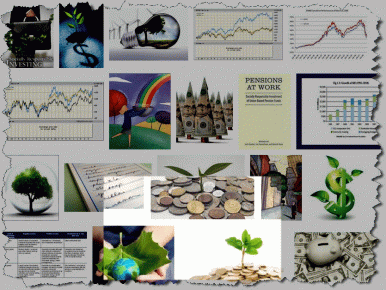Should you worry about this “negative interest rates” business going on in world fixed income markets? A lot of professional managers are worried, so should we more average investing humans be worried as well?
Negative Interest Rates are strange
Negative Interest Rates explained
Now let’s consider where negative interest rates come in…
Fixed Income investments and lower interest rates
Now we turn our attention to investors who are looking for longer term fixed income investments. How do reduced interest rates impact on longer term fixed income investors?
Let’s assume that there’s a loan out there in FixedIncomeLand that was negotiated when a government needed to raise money to pay for a school or a submarine or an illegal kickback or some other such necessary piece of government expenditure. Let’s say that this loan amounted to $100 million and the government agreed to pay an interest rate of 3% a year on the $100 million. That’s pretty much what a government bond is, and even if it’s a bit of a rough example, we’re going to go with it for the moment. So the government is expected to make its payment of $3 million each year until the maturity of the bond in say, 10 years. You’ve handed over $100 million and in return the government has agreed to pay you $3 million a year for those 10 years. So over the full term of the loan, you will receive $30 million in interest and your $100 million back in 10 years time.
Now let’s assume that you’re suddenly cash-poor and the $3 million annual interest isn’t cutting it any more so you want your $100 million back. Except you can’t just do that because the government quite rightly says “nup – we’ve only got to pay the interest bill and don’t have to cough up $100 million for a number of years yet”. Or something sophisticated like that. So you have to go onto the open market and try to sell that loan/note/bond/fixed-income-security to someone else.
It just so happens that you are lucky because interest rates have now reduced from the 3% level that applied when you invested into that $100 million loan. The result of reducing interest rates is that someone with $100 million to invest into fixed income markets today for a 10 year term security is going to receive less than 3% a year as an interest income. Lucky you is standing there holding a loan/note/bond/fixed-income-security that is guaranteed to pay $3 million a year for the balance of its term. So clearly, your piece of paper is worth a lot more than any fresh note being issued, and so it is worth more than $100 million on the current market. There are all sorts of formula for calculating the value of a fixed income note but for the sake of the exercise, let’s just assume you can sell your particular note for $130 million. How cool is that? You’ve just made money from a fixed income investment! And all you were originally after was a regular income and some capital security. So you’re ok and you’ve made a good profit from a “safe” investment.
This is where it gets tricky though, isn’t it? The person you sold your note to has bought it with the knowledge that they will receive $3 million a year until maturity, at which stage they will receive $100 million. In other words, that person is happy to earn about 2.3% interest a year on their $130 million and will lose money at maturity, when they only receive $100 million. On the face of it, they have just guaranteed themselves a loss when that maturity comes along.
It doesn’t make much sense, does it? I certainly have trouble understanding it, even when having a reasonable idea of how the figures are arrived at. I just don’t understand why anyone would willingly agree to buy a loss-making investment. And frankly, nor does anyone else. Which is a bit of a worry because it means that we have no clear historical precedent from which to set up a plan to deal with any unexpected outcomes. When i say “we”, i am referring to professional fund managers, analysts, institutional decision makers, policy-making legislators, financial planners and investors. In other words, anyone that is trying to work out what to do with money.
How about a real world example?
Here’s one way of looking at this fixed income and changing interest rates business. We’ll spend more time on negative interest rates but for the moment, we’ll focus on reducing interest rates, and to do that we will look at a listed security with the code “GSIQ30”. It’s a security listed on the Australian Stock Exchange (“ASX”) that allows you to buy and sell an investment based on the price of an underlying government fixed income security. In other words, it’s the Reserve Bank of Australia working with the ASX to provide a facility for “average” Australians to buy a smaller chunk of a much larger fixed income investment. The RBA do this because government securities are usually traded in hundreds of thousand dollar or even multi-million dollar chunks, so they are not for your average investor. I have chosen this particular security out of the range of listed government bond investments because i bought it a while back and recently sold it, so maths of it all is still fairly fresh in my mind.
When you look at this example, try to remember that you are looking at a “defensive” asset – fixed income is usually considered the “safe” part of an investment portfolio.

This chart shows the price of a government bond that pays a 2.50% interest “coupon” through until its maturity on the 20th September 2030. According to IRESS, it has paid distributions of 285.01 over the past year, giving a yield of 1.93% at the last traded price.
Now look at that price and how much it has varied since the security (code “GSIQ30”) was listed on the ASX back in 2013… Anywhere from $113.93 to $149.45.
Is that what you expect from a “safe” fixed income investment?
On Friday the 12th August, you could buy the GSIQ30 securities for $148.96 or sell them for $148.50 according to the offer and bid prices of the day.
To bring this back to the story of interest rates – the underlying securities have a “Face Value” of $114.32. That’s the current “redemption amount at maturity” figure, which you can find on the Australian Government Bonds website. So you are potentially paying $148.96 for a fixed income note with a maturity value of $114.32. It’s not quite that simple in this case though, as these are “indexed” Treasury bonds, which means the “Face Value” of the security is altered in line with a calculation for inflation. So if inflation continues to roll along at say 2% a year for the next 14 years or so then the amount payable at maturity could be something closer to $150’ish per GSIQ30 security.
So anyone buying this security today is expecting to receive a current yield of about 1.93%pa if interest rates stay as they are today and they may be hoping that inflation runs at a level that will get their original capital back. But here’s a thought… What if rates go back to somewhere near where they were back in 2013/14, and what if the price of GSIQ30 moves back closer to its current “Face Value” of $114.32? If this occurs then that’s a fairly big capital loss for every security you bought. More precisely, $35.13 per security, which works out at a bit over 23% loss. That is not what you expect from a fixed income security!
Negative Interest Rates and professional money managers
I am simplifying things quite a bit here, as professional portfolio managers are able to use all sorts of cleverness to improve returns and reduce the risks for the investing that they do. One example is to invest into shorter time frame maturities. Shorter investment timeframes tend to mean that any change in interest rates isn’t going to have as much impact. One of the reasons that GSIQ30’s price moves so much for any given change in interest rates is that there is still over 14 years of interest payments to be made by that security. Some fund managers have reduced their exposure to these longer timeframe investments. Many fund manager updates and analyst discussions that i have attended over the past year or three have focused heavily on the actions being taken to reduce the potential impact of interest rate rises, so this strange negative interest rates scenario and its impact are being taken into account when making decisions with other people’s money.
Who cares about negative interest rates?
Even though negative interest rates are a strange concept to me, i very much do care about their potential to impact on money and my clients and myself and even how they could impact global politics. Maybe that is just because i tend to worry about such things so please don’t start fretting about every potential interest rate change. Remember that this is just my way of musing through a particular issue – in this case negative interest rates – and i’m sharing this with you because my experience suggests that some people are interested in such things, and more importantly, are interested in the thoughts and impressions of someone relatively close to the money scene. The world of money and advice has become a perilous place, as regulators and compliance folk are suggesting that just about everything a financial planner says and does constitutes advice of one kind or another – so before going much further on negative interest rates and my thoughts, this becomes a good time to repeat the Great Disclaimer…
The Great Disclaimer
Nothing in this post or on this site is to be interpreted to be personal financial advice. It is general advice only and you must not take any actions based on this general advice without first undertaking appropriate research or obtaining advice from a suitably qualified professional to ensure that it is applicable to your personal financial position, attitude to risk, needs and objectives. Where applicable, you should read the relevant Product Disclosure Statement (“PDS”) and obtain further research in regards to any products or services mentioned before making any decisions. Any information presented is relevant only for the period being discussed and rates and returns mentioned can change daily or even intra-day.
Less eloquently, these are my musings and in my eyes they don’t even constitute general advice – so you’d be a fool to take any action in regards to your personal financial position based around this post or across my musings website generally. Even if i do know you and your personal financial position, i am directing these musings into the general community, so there is no way i can account for the different positions of different people who will read these notes.
Why negative interest rates?
You and i both know that most central bankers aren’t crazy. In fact, they are prudent, knowledgeable, capable people who have a huge scope of education and experience that they bring to play in an effort to look good at their job. It’s much the same with private market traders and bankers, other than there being a higher likelihood of a crazy or two – but that’s just statistics, and we’re here to muse on negative interest rates.
What is a Fair Market Value?
So it all becomes a matter of trying to stick to basics and hoping that this debacle of an interest rate regime will eventually settle into some sort of equilibrium based on that basic old mantra for a “fair market value”.. We can turn to good old Wikipedia for a definition at this point…
“Fair market value (FMV) is an estimate of the market value of a property, based on what a knowledgeable, willing, and unpressured buyer would probably pay to a knowledgeable, willing, and unpressured seller in the market.”
[you will notice that the quote uses the term “property” but it’s reasonable to apply that to the value of financial assets]
If you grab a cuppa and ponder that definition for a while, you will realise that we do not have all the required conditions under which you could establish a “fair market value”. And here’s why..
Central bankers across the developed world are creating money out of thin air and using that new currency to purchase fixed income securities (“bonds”) issued by governments and highly rated institutions. So far, so good. They would have to pay what everyone else would pay.
“The benchmark 10-year borrowing rate fell to an all-time low of 0.51 per cent yesterday as the BoE successfully completed its third day of QE after failing to buy 1.17 billion pounds of long-dated paper on Tuesday. Rates on long-dated 30-year gilts fell to 1.26 per cent for the first time as investors bet the bank would be forced to pay sharply higher prices for the debt to meet its purchase targets.” (from the article “Large-scale BoE buying sends bond yields to new lows”, reported on page 27 of the Australian Financial Review, Friday 12th August 2016).
Why does Fair Market Value matter for interest rates?
Well, in this case, it matters quite a bit. If the government bond market price isn’t being set by “pure” market forces then the price may move a long way from true “fair market value”. Again, so what you ask? It’s actually an extremely important issue to the world of money, and therefore either directly or indirectly to both you and i.
Government bond rates are used as a benchmark for standard valuations of future cash flows. In assessing the price to pay for a particular asset (say a building or a business), someone is going to add up all the cashflows and capital dollars expected to be paid or received, and then apply a discount of the ‘risk-free rate‘. The ‘risk-free rate’ is the rate of return that could be expected from an investment that is free of risk. In practice, the rate applied is often the government bond rate, as it is by default assumed to be the prime risk-free asset. After all those calculations, a price is magically created. So off the purchaser goes, armed with a pretty intense calculation of the value they are likely to receive for the risks they are taking in using their money to buy this property or business. If the government bond rate varies too much from a reasonable future money expectations then it is possible that person has just paid too much (or if they are lucky too little) for that asset.
As you would imagine, there is a lot of room for bubbles and busts in various markets if purchasers are all operating off faulty basic numbers. Valuers aren’t dumb to the impacts these strange government bond rates are having, and there has been a lot of debate and work done to try to keep cashflow-based valuations robust and workable – an example is this working paper from Ernst & Young.
What is actually going on here?
Now we are going to indulge in some Michael’s Musings, based purely on my own thoughts and impressions. In other words, i’m just as likely to be wrong as i am right, and anything i say from here should be taken with a grain of salt…
Questions of negative interest rates, ‘quantitative easing’, ‘helicopter money‘ and the like are all issues of Central Bankers attempting to manipulate the supply of money in an attempt to meet their economic targets or mandates.
Why are they feeling they have to do this?
As i said earlier, Central Bankers aren’t usually seen as extravagant or entrepreneurial types, so ‘experiments’ with monetary policy such as negative interest rates, wouldn’t be tackled unless there were some fairly compelling reasons. Logic and traditional economic theory suggest expanding money supplies after big shocks – such as the Global Financial/Banking Crisis – can help reduce some of the pain and value destruction that such shocks cause. More money should keep economies ticking along and lower or negative interest rates should help reduce business lending costs and increase spare cash for those with variable interest loans. Extending this fundamental economics into the world of grand experiments is a big step. Traditionally, governments would look to increase their spending in recessions, in an attempt to create jobs and demand. Projects that improve communications, transport and logistics are obvious targets for government money, and in a difficult environment it is possible that only governments have the will and the capacity to get such projects kick-started. In the absence of private market activity and demand, and if governments aren’t going to do their bit to stimulate the economy then central bankers will have to use more and more experimental strategies to achieve their aim.
Governments aren’t fulfilling their role in all this
Can’t government just get in there and get some big projects running? Post the GFC there has been a huge focus on reducing government debt rather than borrowing more for productive projects. Reducing or eradicating budget deficits has almost assumed a ‘Holy Grail’ crusade status. Yet standard economic theory suggests that it is quite sensible for a government to undertake such activities. You would think that borrowing to improve current and future national productivity, and doing so at the lowest or even negative interest rates, would be just simple, plain sense. But politics are getting in the way of simple plain sense, and governments around the world are having trouble gathering enough support to hold on to power – never mind actually doing some long term planning and strategy to help the nation.
So governments are generally NOT helping the situation. In fact, you could say that sitting by and doing nothing actually contributes to the worsening of the situation. Think of Australia’s position post the ‘mining boom’. Tens of thousands of workers were suddenly freed from mining jobs and all those skills were/are available to government to kick-start some good projects. Salaries and pay expectations have been shot to pieces – so improving chances of such projects being finished on time and on budget. Australia’s demographics are more positive than most developed nations, and expectations are for large increases in total population, with the likely grief to transport and communication and water and electricity infrastructure that such growth creates. So wouldn’t this be a pretty good time to get up and put some dollars into setting the country up for that future?
Nup. Not happening.
Low or negative interest rates are of little use if they are not being used to produce productive assets. Central banks can lay out the trough of water but you need governments to set the conditions that will be conducive to private investment and government projects being led up to drink from that trough. There are very few places in the developed world where that is happening.
Perhaps it is a result of the ageing of most developed nation’s populations? Perhaps it is an increased conservatism brought about by this greater ‘grey power’? Perhaps it is a result of populations looking at their accumulated wealth and thinking they really would rather keep what they have than aim for more? Whatever it is, the conditions under which governments could fulfill their traditional role post market crashes, are not being met. So it may be some time before economies actually move back to ‘historical averages’. In fact, a lot of discussion is currently taking place to suggest that historical averages are no longer relevant or that averages will substantially reduce from those historical figures. For the older amongst us (that’s me), such suggestions sound eerily familiar to the old “it’s different this time”.
Except that it rarely actually is different, is it?

Government of the people, by the people, for the people can sometimes result in a bit of a free-for-all.
Enjoy your weekend!
Disclaimer and Disclosure
I’m an opinionated, arrogant, biased financial planner and may only be semi-educated on most of the matters raised in my post. So it’s best you don’t pay me much attention – although adulation and inappropriately gushy praise will not be rejected.
Feel free to comment. I may even respond. And feel free to critique or criticise. Although i may not respond to that. But don’t let that stop you.










1 comment for “Negative interest rates are strange”